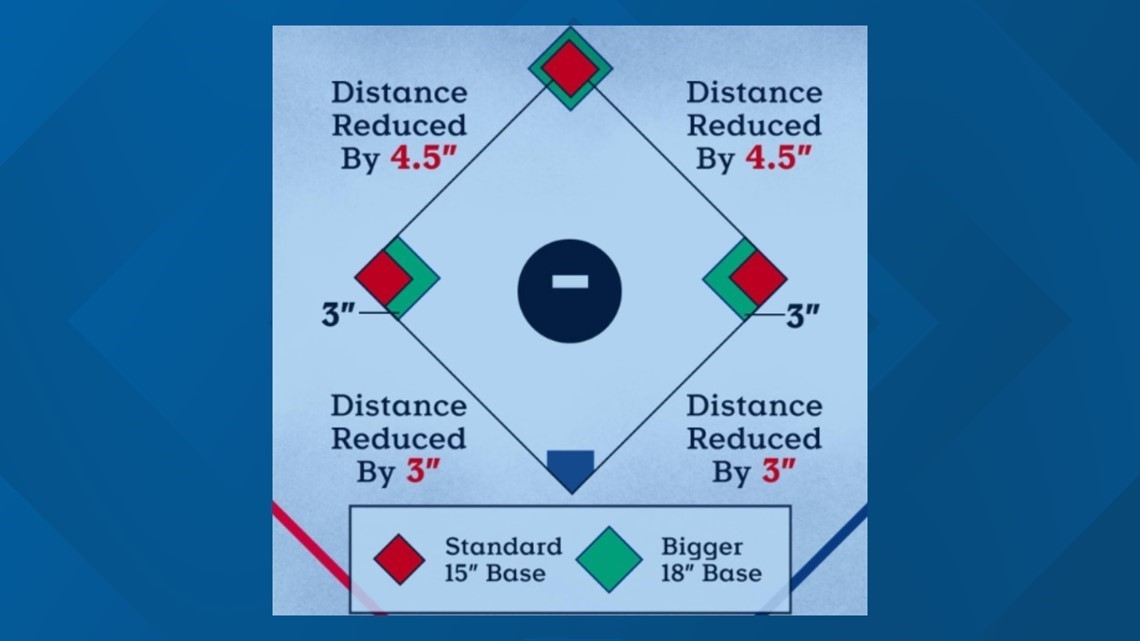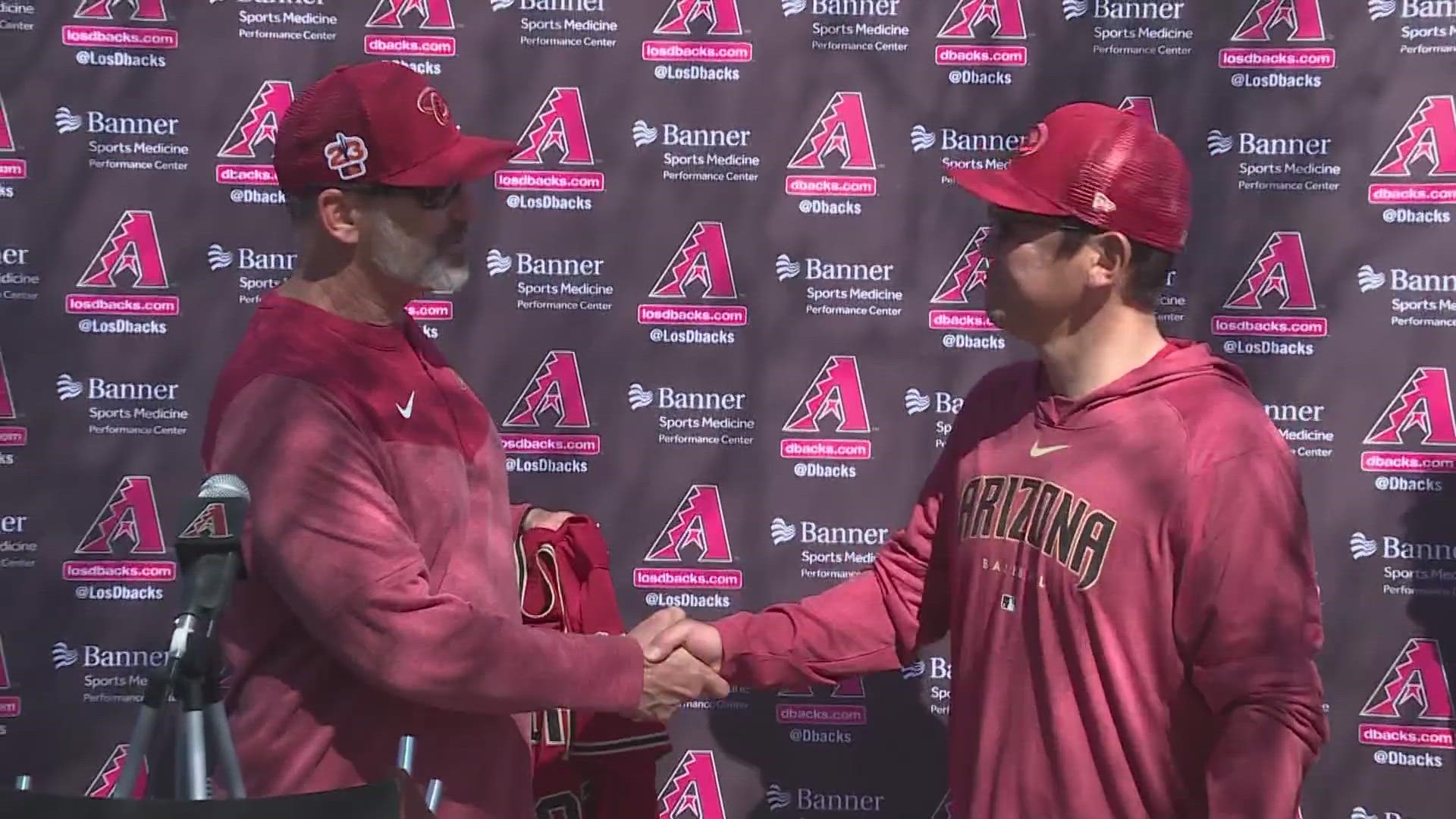PHOENIX — Baseball has been trying to get ... faster.
Better pace of play, more time spent with the baseball in play and more action on the bases were the primary goals of Major League Baseball's (MLB) sweeping rule changes for the 2023 season (and beyond). But it was really about shifting the game's pace upwards to try and retain -- and even grow -- a shrinking audience.
Thus, a sport that typically prefers to never change is making not one, not two, but three big changes to its rules in one offseason.
We took a look at each of the changes and what they mean for the Diamondbacks.
MLB's change: Pitch clock and limited pickoffs
What is the rule? Effective immediately, pitchers will have 15 seconds to begin their throwing motion once the catcher returns the baseball to them. Pitchers will have 20 seconds between pitches if there is a runner(s) on base.
At the same time, the hitter must be in the batting box “and alert to the pitcher” with eight seconds left on the pitch clock. Violations will result in a ball if a pitcher is at fault or a strike if the batter is at fault.
At the same time, pitchers will only be allowed two "disengagements" (pickoff attempts or step-offs) from the mound per batter. Violate the rules? It's a balk.
Why did MLB change these rules? "Less waiting and more action," the league said in a tweet outlining its rule changes. The pitch timer helped reduce game time by 25 minutes in the minor leagues last season, according to MLB.
Limiting pickoffs led to a 26 percent increase in stolen base attempts in the minor leagues.
How will this affect the Diamondbacks?
Diamondback pitchers will need to adjust, and quickly, to adhere to this rule. Not one pitcher on the staff last year, had a tempo of fewer than 15 seconds with the bases empty in 2022, according to Baseball Savant's Statcast tracking. No Diamondbacks pitcher had a tempo of fewer than 20 seconds with runners on base.
Here's how D-backs pitchers fared in tempo with the bases empty in 2022. Remember, the pitch clock will be 15 seconds in this case.
- Zach Davies: 16.1 seconds
- Zac Gallen: 16.9 seconds
- Merrill Kelly: 17.0 seconds
- Madison Bumgarner: 17.4 seconds
- Humberto Castellanos: 17.7 seconds
- Caleb Smith: 18.2 seconds
- Tommy Henry: 18.8 seconds
- Joe Mantiply: 18.8 seconds
- Mark Melancon: 20.6 seconds
- Ian Kennedy : 21.0 seconds
- Noe Ramirez: 23.1 seconds
And here's how quickly Diamondback pitchers were in 2022 with runners on base. Pitchers will have 20 seconds to deliver the ball this season. Only Madison Bumgarner got close.
- Madison Bumgarner: 20.2 seconds
- Tommy Henry: 21.8 seconds
- Caleb Smith: 22.0 seconds
- Humberto Castellanos: 22.3 seconds
- Joe Mantiply: 22.8 seconds
- Merrill Kelly: 23.0 seconds
- Zach Davies: 23.5 seconds
- Ian Kennedy: 25.3 seconds
- Luis Castillo: 23.8 seconds
- Zac Gallen: 26.8 seconds
- Noe Ramirez: 26.8 seconds
- Mark Melancon: 28.6 seconds
There will surely be growing pains with the pitching clock for all teams, but the Diamondbacks are need to feel the need for speed.
MLB's change: Shift restrictions
What is the rule? Two infielders must be positioned on either side of second base when the pitch is released and four infielders must have both feet within the infielder when the pitcher is on the rubber.


One important caveat: If a shortstop started sprinting towards second base, crossing it as the pitch is delivered, it won't be deemed legal because it's considered a way to skirt the shift ban.
The shift ban does present the possibility of a "two-man outfield," with a center fielder and right fielder, along with a left fielder set up where the infielders used to be prior to the shift ban. If the two-man outfielder becomes popular in 2023, however, MLB could opt to ban that in future seasons.
Why did MLB change this rule? MLB said shift restrictions increased batting average and decreased strikeouts in the minor leagues, "giving players more opportunity to show off their athleticism."
How will this affect the Diamondbacks? The shift ban will likely favor left-handed hitters that hit a lot of grounders and pull the ball. Outs that were grounded into the shift in previous years could turn into hits this season, leading to a higher batting average.
Ketel Marte (42.7 pull percentage) and Josh Rojas (32.7 pull percentage) could see a slight uptick in batting average with the shift ban.
MLB's change: Bigger bases
What is the rule? MLB increased the size of the first, second and third bases from 15 inches to 18 inches. The distance from home to first base was decreased by three inches and the distance from third base to home was also decreased by three inches. Bigger bases mean the distance from first base to second base will be shortened by 4.5 inches and the distance from second to third base will be decreased by 4.5 inches


Why did MLB change this rule? MLB said the bigger bases will have a positive impact on player safety. Injury events near the bases dropped by 13% in the minor leagues last year, according to MLB.
How will this affect the Diamondbacks? Another tradeoff of bigger bases is that it will, theoretically, lead to more players trying to steal bases. That is one of the reasons the Diamondbacks signed rookie outfielder Corbin Carroll to that 8 year, $111 million dollar contract. Corbin has the fastest sprint speed, feet/sec (30.7) in the Major Leagues according to Baseball Savant.
Arizona sports
Stay up-to-date on the latest Arizona sports stories with 12News here:

